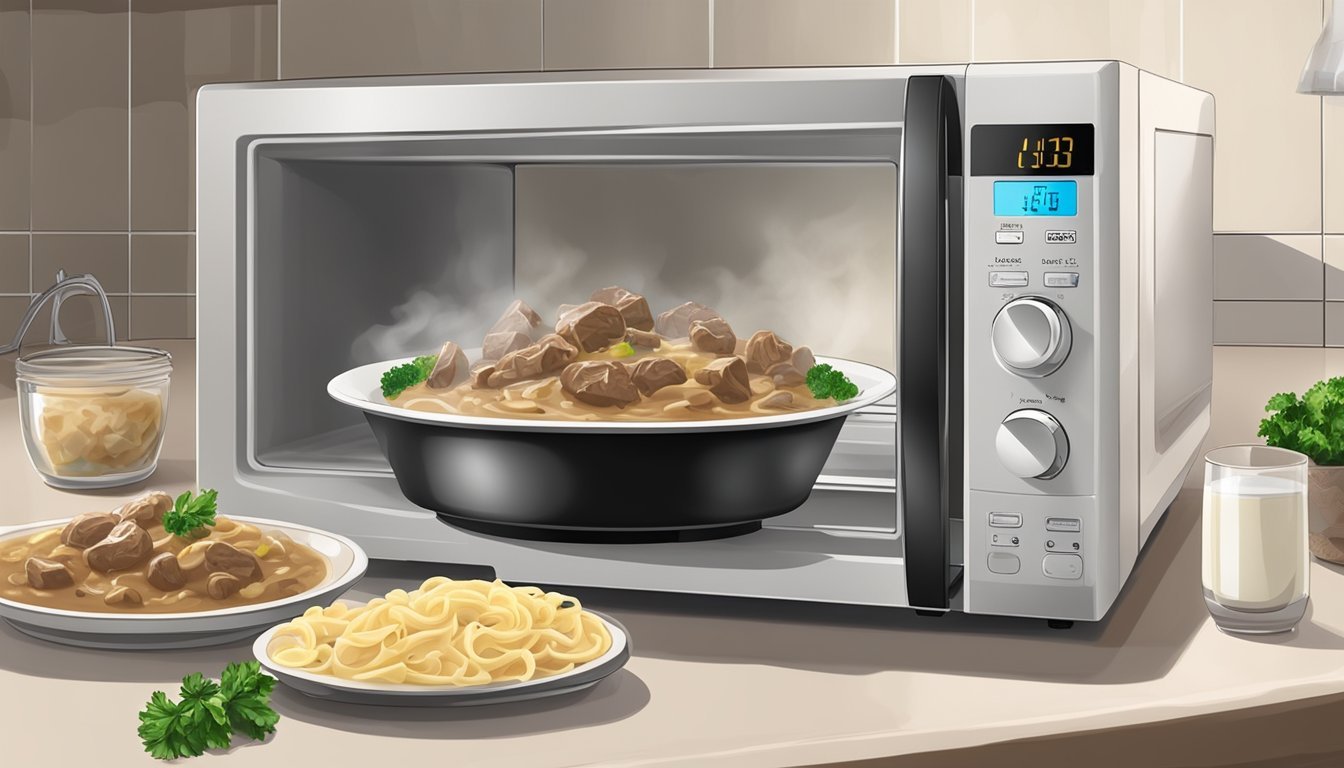How Long Do Beef Stroganoff Bites Last?
Storage Tips and Shelf Life
Beef stroganoff, a savory and creamy dish, has been a timeless favorite for many. One common question for those who enjoy this meal is, "How long will beef stroganoff bites last?" Beef stroganoff can last for up to 3-4 days in the refrigerator when stored properly. Proper storage in an airtight container is essential to maintain its flavor and freshness.
Making beef stroganoff at home is straightforward. The process typically involves sautéing beef, onions, and mushrooms, then combining them with a rich sauce made from sour cream, beef broth, and spices. This classic recipe ensures the dish is both satisfying and easy to prepare.
Understanding the shelf life of beef stroganoff bites is crucial for anyone planning their meals. Well-stored leftovers can provide convenient, delicious options for several days, ensuring you make the most out of this hearty dish. By following these guidelines, you can enjoy your beef stroganoff to the fullest while keeping food safety in mind.
Ingredients Overview
Understanding the components of Beef Stroganoff Bites is essential for a well-balanced dish. This includes the main ingredients, seasonings, and the nutritional value each component contributes.
Key Ingredients
Beef Stroganoff Bites rely on tender cuts of beef like ribeye, sirloin, or flank steak, although ground beef or chuck roast can also be used. The sauce typically includes sour cream, beef broth, and flour to create the signature creamy texture. Essential vegetables like mushrooms and onions add both flavor and texture, while butter enhances the richness.
Noodles and Alternatives
Though egg noodles are traditional, other bases like pasta or even rice can provide versatility in serving. Spiral or whole wheat pasta offers a healthier twist, while cauliflower rice caters to low-carb diets. These alternatives don't drastically alter the flavor but provide different textures and nutritional profiles.
Seasonings and Enhancers
Seasonings such as salt, black pepper, and Worcestershire sauce are pivotal. Dijon mustard and fresh thyme deliver subtle complexities, while garlic and onion powder round off the flavor profile. These enhancers ensure the taste remains robust and savory.
Potential Substitutes
For those with dietary restrictions, Greek yogurt can replace sour cream to reduce fat content. Vegetable broth is a good substitute for beef broth for a vegetarian variant. Olive oil can replace butter for a lighter option, and even chicken can replace beef for a different take.
Nutritional Information
A serving of Beef Stroganoff Bites typically contains around 350-400 calories and 20-25g of fat. The dish is rich in protein from the beef and provides substantial amounts of B vitamins, iron, and zinc. Monitoring portion sizes can help manage calorie intake without sacrificing flavor or nutritional value.
Freshness Indicators
Key signs that the dish is still fresh include a consistent odor, vibrant color, and proper texture. The sauce should be creamy without separation, and the beef should remain tender. Signs of spoilage include a slimy texture, discoloration, and any signs of mold growth.
Specific Ingredient Handling
Proper handling of each ingredient is crucial. Beef should be stored at the right internal temperature and thawed properly if frozen. Sour cream and other dairy products should be refrigerated immediately after use. Mushrooms and onions should be fresh and stored in a cool, dry place to maintain their quality.
Preparation and Cooking
Cooking involves browning the beef first, then sautéing mushrooms and onions in butter. Combining beef broth, Worcestershire sauce, and Dijon mustard with a bit of flour ensures the sauce thickens correctly. Finally, finishing the dish with sour cream or Greek yogurt gives it the signature creamy texture.
Serving Suggestions
Beef Stroganoff Bites pair well with sides like roasted broccoli or a simple green salad. For a heartier meal, incorporate egg noodles or pasta. These bites serve as a convenient weeknight meal that's both kid-friendly and indulgent. Garnish with fresh parsley or chives for added color and flavor.
Storing Beef Stroganoff
To ensure the safety and flavor of beef stroganoff, it is crucial to store it properly using specific guidelines. This section will provide detailed information on the ideal storage conditions, shelf life in the refrigerator, freezing and thawing tips, signs of spoilage, and best practices for leftovers.
Ideal Storage Conditions
Beef stroganoff should be stored in airtight containers to minimize exposure to air and moisture. Cooling it quickly after cooking and then refrigerating it is essential to slow down bacterial growth.
A refrigerator set to 40°F or below is optimal for storing this dish. Covering the food with a tight lid also helps retain its texture and flavor.
Shelf Life in the Fridge
Freshly prepared beef stroganoff can last for 3-4 days when stored in an airtight container in the refrigerator. Proper storage is key to keeping the dish safe from bacterial contamination and maintaining its taste.
Always use a fridge thermometer to ensure that the temperature remains below 40°F. If in doubt, it's better to consume sooner rather than later to avoid foodborne illnesses.
Freezing and Thawing Tips
To extend the shelf life of beef stroganoff, freezing is an excellent option. When freezing, use freezer-safe containers and leave some space for the food to expand.
Beef stroganoff can be kept frozen for 2-3 months. When ready to use, thaw it in the refrigerator overnight. Reheat gently on the stove or in the microwave until it reaches 165°F to ensure it is safe to eat.
Signs of Spoilage
Check for spoilage by inspecting the beef stroganoff for any discoloration, mold growth, or off-putting odor. If any of these signs are present, it is best to discard the dish to prevent foodborne illnesses.
Consuming spoiled food can lead to serious health issues, so always err on the side of caution.
Best Practices for Leftovers
After preparing or serving beef stroganoff, refrigerate leftovers promptly, ideally within two hours. Divide the dish into smaller portions for quicker cooling.
Ensure that the containers are adequately sealed to prevent exposure to air and moisture. Label the containers with the date before refrigerating or freezing, helping keep track of the dish's shelf life.
Reheating Beef Stroganoff
Reheating beef stroganoff effectively ensures the dish retains its flavor, texture, and safety. The following methods highlight best practices to achieve optimal results, maintain quality, and ensure food safety.
Methods for Reheating
Oven Method
Preheat the oven to 350°F (175°C).
Transfer beef stroganoff to an oven-safe dish.
Cover the dish with aluminum foil to prevent drying.
Bake for 20-25 minutes, stirring halfway through.
Ensure internal temperature reaches 165°F.
Microwave Method
Place beef stroganoff in a microwave-safe container.
Cover with a lid or plastic wrap, leaving an opening for steam.
Microwave on high for 2-3 minutes per serving.
Stir halfway through to ensure even heating.
Stovetop Method
Place beef stroganoff in a pan over low heat.
Add a small amount of broth or cream to prevent drying.
Stir occasionally until heated through.
Maintaining Quality During Reheating
Retaining moisture and texture is crucial during reheating. Techniques include:
Adding Moisture: Incorporate a few tablespoons of broth, milk, or cream to retain the creamy sauce and prevent drying.
Stirring Regularly: Regular stirring helps distribute heat evenly, maintaining the texture and preventing the dish from becoming rubbery.
Avoid Overcooking: Monitor closely to avoid overcooking, which can make the beef tough.
Safety Considerations
Food safety is essential when reheating. Important measures include:
Internal Temperature: Ensure the beef stroganoff reaches an internal temperature of 165°F to kill any harmful bacteria.
Storage Duration: Store leftovers in an airtight container in the refrigerator and consume within 3-4 days.
Reheating Once: Reheat only once to reduce the risk of bacterial growth.
Impact on Nutritional Values
Reheating can affect nutritional values:
Caloric Content: Minor losses in calories may occur but are generally minimal.
Nutrient Retention: Some nutrients, especially sensitive vitamins, may degrade slightly during reheating.
Protein and Fats: The beef and sauce's protein and fat content remain largely unaffected by reheating.
These practices ensure beef stroganoff remains flavorful, safe to eat, and nutritious after reheating.
Conclusion
Proper storage is essential for maintaining the quality and safety of beef stroganoff bites.
Refrigeration: Freshly cooked beef stroganoff should be stored in an airtight container and can last 3-4 days in the refrigerator. Leftovers should be consumed within 2-3 days.
Freezing: Beef stroganoff can be frozen to extend its shelf life. Cooked beef stroganoff can last 2-3 months in the freezer. Ensure it’s stored in a suitable container or freezer bag.
Signs of Spoilage: Always check for signs of spoilage before consuming. Look for changes in smell, color, and texture.
Serving Tips: When serving, ensure the beef stroganoff bites are reheated thoroughly to an internal temperature of 165°F (74°C). This ensures any potential bacteria are killed, keeping the dish safe to eat.
Following these guidelines ensures tasty and safe beef stroganoff bites every time. Proper handling is key to enjoying this delicious dish longer.






